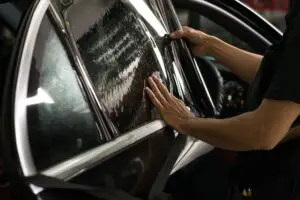Window tint laws have been a part of the state of Michigan since the year 2000, when they were first enacted, and have since become the norm in the state and other states, making it likely you will have to follow some version of them.
Michigan window tint laws are fairly straightforward.
You cannot have any reflective tints on your windshield, and any tints you do end up applying must be above the first 4 inches of the windshield.
This is the same for the front seat side windows, but the back seat side windows do not have any sort of rules surrounding them, and this is the same for the rear windows as well.
If you want to go further in-depth and see all of the tint laws, then make sure to read the whole article.
Table of Contents
- 1 How Much Tint Darkness Is Legal In Michigan?
- 2 Window Tint Reflection And Tint Colors
- 3 Medical Exemption Of Window Tint Laws In Michigan
- 4 Get A Certified Sticker From The Company
- 5 Other Window Tint Law Rules And Regulations In Michigan
- 6 Cost Of Car Window Tint In Michigan
- 7 Frequently Asked Questions
- 8 Conclusion
How Much Tint Darkness Is Legal In Michigan?

There is no set tint of darkness in the state, and people can use whatever tints of darkness they want.
Many states have a specific amount of VLT that the people cannot cross.
This allows law enforcement to easily check-in inside the windows while drivers can apply tints of any darkness they want.
Tint Darkness Limit For SUVs And Vans
Getting into window tints for sports utility vehicles and vans, you first have to make sure that there is no reflective tint applied on the windshield.
Any tints you apply to the windshield must be limited to the first 4 inches of the screen. Beyond this, you can be liable for a fine.
Moving onto the front seat side windows, there is no VLT restriction which allows you to have tints of any darkness you want, but this must also be limited to the top 4 inches of the windows.
Luckily, this second part is dropped when it comes to the back seat side windows, and instead, you can simply apply any legal tint of your choice, regardless of any VLT level.
This continues for the rear windows, which can get as dark as you want them to.
Tint Darkness Limit For Sedans
If you were wondering about the rules for sedans, you would be glad to know that they are identical to the ones for sports utility vehicles.
Here they are for each of the main windows:
1. Front Windshield
The rule for the front seat side windows is carried forward for the front windshield, which can only use tints that are nonreflective and limited to the top 4 inches of the windshield.
2. Front Seat Side Windows
Like SUVs and vans, the front seat side windows can have any tint or darkness of your choice. However, the tints must be set on the top 4 inches of the windows.
3. Rear Window
Things get a lot more lenient when it comes to the rest of the windows, as starting from the rear window, you can use whatever darkness you want.
4. Back Seat Side Windows
This includes the back seat side windows, which follow the same rule and can use whatever darkness the user wants them to have.
Window Tint Reflection And Tint Colors
- Michigan has laws related to how much certain reflective windows can be.
- The front-seat side windows can only be 35% reflective at most and should not be beyond this threshold.
- This rule is applied to the back seat side windows as well, and you should try your best that the reflectiveness does not exceed 35%
- Most window tint colors are allowed in Michigan, and you are free to use whatever colors you want.
- There are only two colors that are not allowed. These include:
– Silver
– Gold
Medical Exemption Of Window Tint Laws In Michigan

When it comes to window tint laws, the biggest factor that many people depend on is if the state in question allows for medical exemptions.
Many people suffer from various conditions that prevent them from taking the full force of the sun.
They will have to use special tints when driving or when in cars, and this may not always be legal, so they will require medical exemptions from the law to make sure that they do not break the rules.
Luckily for these people, you can apply for a medical exemption if you are in Michigan. If you are medically exempt, you can tint your windows to any extent.
To become medically exempt, you must start by having a letter from your doctor or physician/this letter must specifically state that you require special tints for medical reasons.
This letter should also include your personal information, such as name and date of birth, along with why you are tinting your windows.
You must have this letter with you at all times when driving.
Get A Certified Sticker From The Company
Many states require their citizens to identify their window tints as legal.
This is usually done by certification stickers placed between the film and the window. These certification stickers are not required in the state of Michigan.
This also extends to the tint manufacturers and how they are usually required to provide certification that the tints they are making are up to the state’s standards.
In Michigan, they are not required to do so.
Other Window Tint Law Rules And Regulations In Michigan
Here are a few more active tint laws in Michigan and rules that you should incorporate into your daily driving.
- If your rear windshield is obstructed, you are legally required to have side mirrors.
- You are not allowed to use gold & silver colors in your window tints.
- Medical exemptions are allowed, but you must have a letter of exemption with you.
- You are not required to certify the legality of your window tints.
Cost Of Car Window Tint In Michigan
If you are searching for a place to legally tint your windows, you should also have the capital required to tint your car windows.
If you are looking for a basic window tint, this can start as low as $150. However, the prices can quickly ram up as you demand better quality, colors, and a lifetime warranty.
If you get high-quality and long-lasting window tints, you can look at prices up to $500 or more, depending on the place you are getting the tints from.
Frequently Asked Questions
Q1. Is 15% Tint Legal In Michigan?
There are no set limits on the window tint darkness in Michigan.
This means that you are free to use whatever darkness you want. This includes the 15% tints, making them legal on all windows.
Q2. Are 5% Tints Legal In Michigan?
Like the 15% tints, you can also apply 5% tints to any window you want.
Since there is no limit to the darkness of the tints that you can apply, you can apply most tints so long as you follow the other rules that come with them.
Q3. Is Limo Tint Legal In Michigan?
If there is no tint darkness limit, you are free to apply limit tints on all the windows of your car; however, you must know that limo tints are usually very dark and prevent a lot of light from entering the vehicle.
Q4. Can I Get Pulled Over For Tint In Michigan?
If you have applied tints on your windshield or the front seat side windows exceeding the 4-inch limit, you are liable to be pulled over by Michigan police.
Q5. How Much Is A Tint Ticket In Michigan?
Tint tickets are a civil infraction and carry a decently sized fine of $95 along with 2 points on your license, so it is something you should avoid.
Conclusion
Michigan tint laws are one of the most relaxed and easy-to-follow tint laws in the United States.
This is mostly because the state does not require any specific values for window tint darkness, leaving it up to the user to decide which tint they want for their windows.
Despite this, however, there are still many rules you should be aware of, and now that you have read this article, all of these rules should be on the tip of your fingers, making it easy for you to obey Michigan’s tinting laws.

I am Tahir Azam, and I have been writing amazing articles for TaxiHack for as long as I can remember. I know everything that is to know when it comes to automobiles and is always on top of industry news and developments. While I am not an expert by any means, I pride myself on knowing the ins and outs of many different problems and, of course, their solutions. The articles on our website are some of the best and well-researched content that you will find, and I spend countless hours making sure this remains to be true. This is why I ask you to take your time out and read some of my articles, especially if you find a topic that resonates with you or is something you are looking into. This way, you will find the perfect mix of information and tips on your desired topic. Learn more about Tahir.



